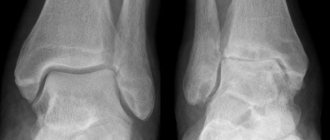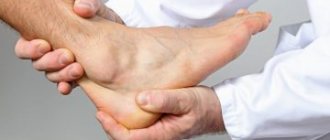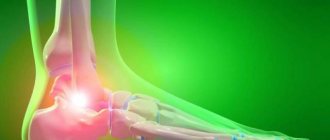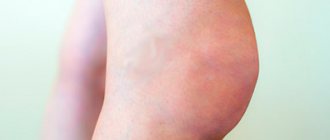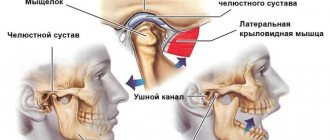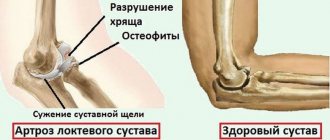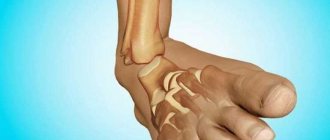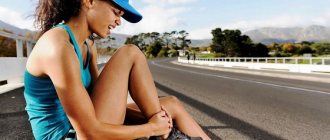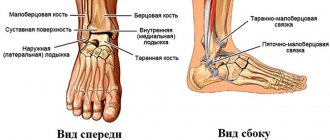With arthrosis in the ankle joint, cartilage tissue is quickly destroyed. These are irreversible processes that cause serious complications. Women and athletes are more susceptible to the disease. Due to improper load distribution, this disease can occur. The disease is also caused by bruises, falls, and damage to soft tissues. Overweight people often suffer from arthrosis due to increased stress on the knee joint.
The ArthroMedCenter Joint and Spine Clinic offers its patients a modern effective method for treating ankle arthrosis - MBST therapy, which allows you to restore the affected joint tissues, as well as completely relieve a person from the disease without pain and operations!
Main stages of the disease
Most modern people are faced with inflammatory processes that occur in bone tissue. It is better to familiarize yourself with the symptoms of such diseases in advance in order to promptly recognize the disease and begin treatment with a rheumatologist. The main symptoms manifest themselves in the form of pain, “crunching” when moving, and decreased mobility of the legs. These are also subluxations, the causes of which are disruption of muscle function, changes in tendons, and swelling that manifests itself in the ankle joint. Upon visual examination, in almost all cases of the disease, the tibia axis acquires an X-shaped deformity.
The first stage of the disease proceeds almost unnoticed; the person complains of fatigue. In the second stage, a person feels sharp pain when moving, swelling appears, decreased mobility of the foot, and weather dependence (joints ache when weather conditions change). The third stage is the destruction of articular cartilage. The shock-absorbing properties of the joint decrease, mobility suffers, and a crunch appears. Modern medicine does not guarantee a complete cure, but can slow down the processes that contribute to the destruction of the joint.
Symptoms of ankle arthrosis
Arthrosis of the ankle is the destruction of cartilage tissue. Signs of the disease and its typical symptoms do not appear immediately. At first, the patient feels some pain in the ankle area only in the morning, in the first hours after waking up. After some time, painful sensations are suppressed as the body begins to produce active painkillers. That is why during this period of illness few people turn to a doctor for help. Gradually the symptoms intensify:
- Severe pain does not go away, and sometimes, on the contrary, intensifies throughout the day;
- The foot swells greatly, it is difficult for the patient to wear usual shoes;
- When walking or other movements of the ankle, crunching sounds are heard;
- At night, the pain is aggravated by cramps;
- The patient's gait changes because the habitual step increases the pain.
Symptoms of ankle arthrosis appear gradually.
The risk of injury, dislocation, bruise and fracture increases, the treatment of which is already complicated by pathological processes in the joint.
Doctors identify excess weight, weightlifting, injuries, improper footwear and certain diseases, including cardiovascular diseases, as the main causes of symptoms. The risk of arthrosis increases with age and ultimately almost every person falls into the risk group.
Treatment of ankle arthrosis with MBST therapy
ArthroMedCenter offers exclusive treatment for ankle arthrosis using magnetic resonance therapy. Today, this is the only technique that is incommensurate in effectiveness with traditional treatment and can replace total endoprosthetics.
MBST therapy is based on the phenomenon of magnetic spin resonance, which occurs under the influence of electromagnetic radiation in hydrogen atoms present in living cells. Briefly, its essence, like the treatment of arthrosis itself, comes down to restoring the ability of affected cells to operate with energy, which leads to their restoration and activation of cellular metabolic processes.
The use of a unique non-invasive technique can significantly enhance the processes of cartilage tissue regeneration by blocking the synthesis of inflammatory mediators, suppressing anaerobic cycles and supporting hemostasis within cells. As a result, it is possible to relieve pain, remove restrictions in mobility, improve tissue trophism and, in general, make the treatment of joint arthrosis better and more effective. It is noteworthy that after undergoing magnetic resonance therapy procedures, tissue growth is observed throughout the year.
Using MBST therapy, ArthroMedCenter offers the most effective treatment for ankle arthrosis. Equally important is the comfort and painlessness of the method. Having undergone the required number of sessions prescribed by the center’s experienced specialists after studying the anamnesis, patients with arthrosis can not only improve their quality of life, but also prevent painful and expensive surgery.
The use of advanced technologies allows our center to take the treatment of arthrosis of the knee joint to a completely new, higher quality level, and guarantee the health of our patients.
Traditional treatment at home
There are quite a few ways to treat foot arthrosis at home.
Classic medicinal, folk, and physiotherapeutic methods are used. sometimes the doctor decides to combine several techniques to achieve the most effective result.
Drug treatment
The need to use medications is due to severe pain and inflammation developing in the ankle. To relieve them, non-steroidal anti-inflammatory painkillers are prescribed. They are used for both indoor and outdoor use.
Pills
The main symptom that affects the patient’s lifestyle and condition is pain. It does not allow you to stand on the sole, so treatment of arthrosis of the feet at home begins with pain relief with tablets. Such drugs as ibuprofen, ketoprofen, nimesulide have proven themselves well. Sometimes instead of NSAIDs, doctors prescribe analgesics: spasmalgon, analgin, viprosal.
Medicines should be taken only after a doctor’s prescription and in the indicated dosage. The period of use of tablets is strictly limited, as they can be addictive. In addition, the doctor must be aware of the presence of concomitant diseases, since some drugs have side effects.
Ointments
For external use, a large number of medicinal ointments are used, with which the treatment of joints becomes more effective. They enhance the anti-inflammatory and analgesic effect of the tablets. It is often recommended to use Voltaren, Fastum-gel, Menovazin, Diclofenac and others. The advantage of ointments is that they do not have a serious effect on internal organs and can be used longer.
Gymnastics for feet
Drug treatment may not be enough to restore normal physical activity. Another available method for relieving painful symptoms is special gymnastics for the feet. It helps speed up recovery processes, reduces pain, and ensures joint rehabilitation.
When performing gymnastics, it is important to follow the basic rules:
- It should be systematic, at least 2 times a day and for at least 10 minutes;
- In the first days, preference is given to a simple exercise, gradually the degree of complexity increases;
- It is important to do the exercises slowly, while monitoring your breathing;
- It is not recommended to start gymnastics until the pain is relieved.
It is better to coordinate a set of exercises with the attending physician who is familiar with the patient’s health characteristics, his medical history and current condition.
Diet for arthrosis
Due to the nature of the disease, doctors recommend additional diet during treatment. To restore cartilage tissue, it is extremely important to obtain the necessary nutrients, vitamins and minerals. All nutrition should be aimed at saturating the body of the person treating the feet with vitamins B, C, unsaturated fatty acids, calcium, and protein. They improve the elasticity of cartilage tissue, preventing its further destruction. You will have to completely eliminate or at least minimize the use of:
- Fatty meats.
- Confectionery products.
- Fast food.
- Sparkling water.
- Spices, sauces.
- Smoked meats.
The patient’s diet should be healthy.
The patient’s menu should include daily:
| Poultry meat | Chicken, turkey |
| Fatty fish | Herring, salmon, sardine, mackerel |
| Natural dairy products | Skim milk, yogurt, cheese |
| Nuts | Almonds, pine nuts, hazelnuts |
| Cereals rich in carbohydrates | Brown rice |
| Fruits and vegetables | Pomegranate, pineapple, avocado, apple |
| Legumes | Soybeans, peas, beans, lentils |
| Eggs | Chicken |
Meals should be frequent, but in small portions, and all dishes should be fresh. It is better to choose boiling or stewing as a cooking method.
Physiotherapy at home
Physiotherapy therapy is prescribed to almost all patients suffering from arthrosis. There are only some contraindications to the use of this treatment method. Among them:
- Pregnancy and lactation period.
- Severe blood diseases, heart diseases, cancer.
- Lesions of the central nervous system, including epilepsy.
- Purulent skin rashes.
If the patient has a history of any of these problems, he should refuse to undergo any physical therapy procedures.
Carrying out a physiotherapeutic procedure
Only certain types of physiotherapy can be performed at home: magnetic, electrophoresis, paraffin therapy. In this case, you will have to acquire special devices or other means.
The number of procedures and their duration should always be determined by the doctor. If all the rules for using devices are followed, physical therapy can help reduce the number of medications taken.
Massage
Ankle massage can be helpful as an adjunct to physical therapy. It has a good effect on the nervous and muscle tissue of the foot, improves blood circulation. At home, massage is performed using medicinal oils. The session itself lasts no more than 25 minutes. During this time, the massage therapist, moving from the toes up the leg, manages to work not only with the part of the foot affected by arthrosis, but also with the area nearby. The course lasts 10-14 days, and it is advisable to conduct it by a specialist familiar with the structural features of the leg.
Massage for this disease improves blood circulation
Treatment of ankle arthrosis
There are several methods for getting rid of arthrosis. As a rule, complex treatment of not advanced forms of the disease using conservative methods is used: drug treatment, physiotherapeutic procedures, gymnastics, lifestyle correction.
In cases where arthrosis is severe, it is customary to use surgical treatment methods, namely:
- Minimally invasive intervention (puncture). A needle is inserted into the joint to withdraw fluid. This is more of a diagnostic method that allows you to obtain material for research, administer corticosteroids to the site of inflammation, and reduce the load on the capsule.
- Arthroscopy is the transfusion of a professional apparatus with a sensor through microscopic incisions in the skin to examine the ankle joint or remove separated fragments of cartilage tissue. This method can eliminate the inflammatory process and pain.
- A periarticular osteotomy involves filing down the patient’s bones and then securing them at a different angle. Surgery can reduce the load on the joint and relieve pain for a long period of time. This type of operation is rarely used, since the burden on the body of a patient of any age is a risk. A long recovery period also plays a role. Periarticular osteotomy is very effective, but it is used only in extreme cases.
- Endoprosthesis replacement is used when other types of treatment for ankle arthrosis have proven ineffective. When the disease has destroyed the joints, they are replaced with special plastic or metal prostheses. Sometimes ceramic dentures are used. This is a complex operation that requires considerable financial costs. Another disadvantage of this method of treating ankle arthrosis is the long rehabilitation period and the patient may experience pain for six months. Despite all the disadvantages, endoprosthetics is the only alternative treatment for a patient at an advanced stage. The prosthesis needs to be replaced after twenty years. All these years a person can live a normal life, forget about pain and inflammation.
All conservative methods of treating arthrosis are, of course, quite effective, however, each of them carries with it some discomfort for the patient. Speaking about surgical intervention, it is worth noting long-term rehabilitation. Today, there is a more modern and comfortable way to treat arthrosis of the ankle joint - MBST therapy, which has been popular abroad for many years. Now innovative treatment is available to patients of our Clinic!
Moscow, metro station Dubrovka, st. Sharikopodshipnikovskaya, 6/14
| Loading map... |
Ankle pain
Conservative treatment
A patient with arthrosis of the ankle joint, especially in the initial stages, requires conservative or non-surgical treatment. Conservative treatment includes the prescription of anti-inflammatory and painkillers. The patient also needs to change his daily physical activity. Axial load on the joint, especially associated with running and jumping, should be limited. This will help reduce pain in the joint area. It is also important to choose comfortable orthopedic shoes for the patient, make individual insoles and fix the ankle joint with a special orthotic bandage.
All these simple procedures will relieve stress on the ankle joint when walking and reduce the manifestations of arthrosis. The use of intra-articular injections of hyaluronic acid preparations and the introduction of platelet-rich plasma (PRP) into the joint cavity, especially in the initial stages of arthrosis, can alleviate the symptoms of damage to the ankle joint.
In case of severe inflammation, glucocorticoids can be injected into the joint cavity. Glucocorticoids can significantly reduce inflammation and pain in the ankle joint.
Surgery
If there is no effect from conservative treatment, as well as if there are signs of total destruction of the ankle joint, surgery may be indicated.
At certain stages of arthrosis, minimally invasive surgical interventions can be performed on the ankle joint using the arthroscopy method.
As mentioned earlier, with arthrosis of the ankle joint, bone spines or osteophytes form along the edges of the bones. Large osteophytes can collide with each other during movements in the foot and ankle and cause pain in the patient. Such osteophytes usually form along the anterior surface of the joint.
Modern equipment allows us to insert a small video camera into the ankle cavity through a skin puncture and examine the joint from the inside. When identifying bone growths and osteophytes, doctors can remove excess bone tissue using a special bone micro-bur and through skin punctures.
During the operation, loose cartilage and bone bodies are removed from the joint cavity, which form in the ankle joint during arthrosis and cause pain and periodic blockages during movement.
Carrying out sanitation arthroscopy of the ankle joint in combination with the subsequent introduction of hyaluronic acid preparations into its cavity can alleviate the condition of a patient with arthrosis for up to 3-5 years. The operation is very well tolerated by the patient and practically does not require the patient to stay in the hospital.
In case of total damage to the cartilage of the ankle joint (arthrosis of the fourth stage), often accompanied by severe deformation of the joint, it is necessary to resort to surgery for arthrodesis of the joint.
The advantage of arthrodesis of the ankle joint is the possibility of significantly reducing the severity of pain due to arthrosis with the patient returning to normal everyday life.
The disadvantage of arthrodesis of the ankle joint is the loss of mobility in it. The function of the ankle joint after arthrodesis is transferred to other joints of the foot.
In general, even though the ankle joint is locked as a result of the operation, the long-term results of such surgical intervention, according to modern research, are more than good.
Previously, surgery for arthrodesis of the ankle joint was performed openly, using wide skin incisions, sometimes even several, and was accompanied by severe pain and swelling in the postoperative period. The evolution of surgical technologies has naturally led to the fact that today ankle joint arthrodesis surgery can be performed minimally invasively, or arthroscopically, through small punctures of the skin.
The benefits of arthroscopic ankle arthrodesis are clear. This includes less severe pain after surgery, more acceptable incisions from a cosmetic point of view, and relatively less trauma to healthy soft tissues during surgery.
However, arthroscopic arthrodesis compared to open surgery is a much more complex intervention from a technical point of view and requires a highly qualified surgeon.
After the operation, the patient is recommended to elevate the limb and fix the foot and lower third of the leg in a special bandage. The load on the limb is eliminated for 8-10 weeks.
More information about the treatment of ankle arthrosis.
